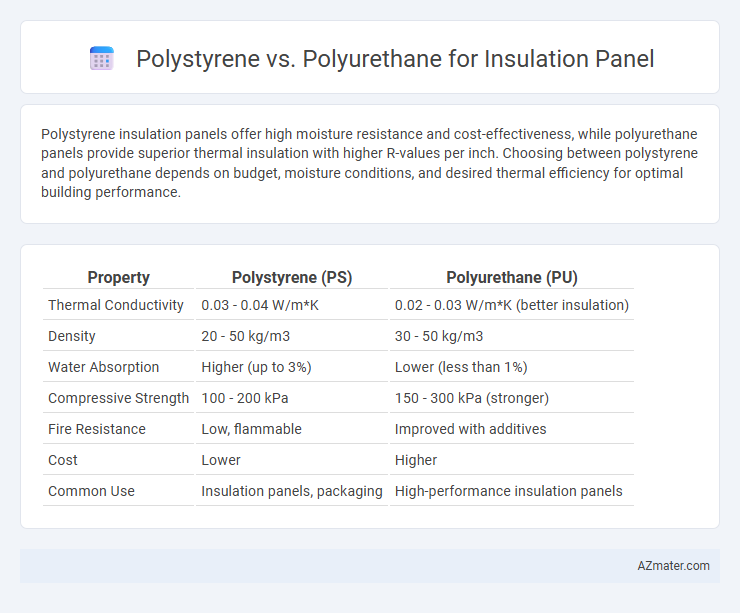Polystyrene insulation panels offer high moisture resistance and cost-effectiveness, while polyurethane panels provide superior thermal insulation with higher R-values per inch. Choosing between polystyrene and polyurethane depends on budget, moisture conditions, and desired thermal efficiency for optimal building performance.
Table of Comparison
| Property | Polystyrene (PS) | Polyurethane (PU) |
|---|---|---|
| Thermal Conductivity | 0.03 - 0.04 W/m*K | 0.02 - 0.03 W/m*K (better insulation) |
| Density | 20 - 50 kg/m3 | 30 - 50 kg/m3 |
| Water Absorption | Higher (up to 3%) | Lower (less than 1%) |
| Compressive Strength | 100 - 200 kPa | 150 - 300 kPa (stronger) |
| Fire Resistance | Low, flammable | Improved with additives |
| Cost | Lower | Higher |
| Common Use | Insulation panels, packaging | High-performance insulation panels |
Introduction to Insulation Panels: Polystyrene vs Polyurethane
Polystyrene and polyurethane are two of the most widely used materials for insulation panels due to their excellent thermal resistance properties. Polystyrene offers a lightweight, moisture-resistant solution with an R-value typically around 4 to 5 per inch, making it suitable for wall and roof insulation. Polyurethane provides a higher R-value, often between 6 and 7 per inch, with superior air-sealing capabilities that enhance energy efficiency in building envelopes.
Material Composition: Polystyrene and Polyurethane Explained
Polystyrene insulation panels consist of a rigid foam made from polymerized styrene, characterized by closed-cell structure that provides excellent moisture resistance and thermal insulation with R-values typically ranging from 3.6 to 5 per inch. Polyurethane insulation panels are composed of a polymer matrix created through the reaction of polyol and diisocyanate, resulting in a high-density foam with superior thermal resistance, often achieving R-values between 6 and 7 per inch. The distinct chemical composition of polyurethane offers enhanced insulation performance and better air-sealing capabilities compared to polystyrene, making it suitable for high-efficiency building applications.
Thermal Performance Comparison
Polystyrene insulation panels exhibit a thermal conductivity (k-value) ranging from 0.030 to 0.040 W/m*K, providing moderate thermal resistance suitable for standard applications. Polyurethane panels offer superior thermal performance with k-values between 0.020 and 0.025 W/m*K, ensuring higher R-values per inch of thickness and enhanced energy efficiency. The lower thermal conductivity of polyurethane results in better insulation effectiveness, making it the preferred choice for projects requiring maximum thermal resistance and reduced heat transfer.
Moisture Resistance and Durability
Polystyrene insulation panels exhibit moderate moisture resistance but can absorb water over time, potentially compromising their thermal performance. Polyurethane panels offer superior moisture resistance due to their closed-cell structure, which effectively prevents water infiltration and maintains insulation integrity. Durability-wise, polyurethane panels generally outperform polystyrene by resisting deformation, chemical exposure, and environmental wear, making them a long-lasting choice for insulation in moisture-prone environments.
Fire Safety and Flammability Ratings
Polystyrene insulation panels, such as EPS and XPS, have lower fire resistance and higher flammability ratings, often classified as combustible materials with a tendency to produce toxic smoke when ignited. Polyurethane foam panels offer improved fire retardancy due to their ability to be treated with flame retardants and typically achieve better ratings like ASTM E84 Class A or Class B, enhancing building safety. Fire safety regulations often favor polyurethane panels for critical applications where reduced flame spread and smoke development are essential.
Environmental Impact and Sustainability
Polystyrene insulation panels typically have a higher environmental footprint due to their petroleum-based production and long degradation period, releasing toxic chemicals if incinerated. Polyurethane panels offer better thermal insulation efficiency, reducing energy consumption over their lifecycle but involve isocyanates in manufacturing, posing health and environmental risks if not managed properly. Choosing sustainable insulation requires balancing material durability, recyclability, and the environmental cost of production and disposal.
Installation Methods and Ease of Use
Polystyrene insulation panels, including Expanded Polystyrene (EPS) and Extruded Polystyrene (XPS), are lightweight and rigid, allowing for straightforward cutting and fitting using standard tools like utility knives, making installation faster and less labor-intensive. Polyurethane panels, while offering higher R-values per inch due to their closed-cell structure, require more careful handling and precise cutting with specialized saws to maintain panel integrity and ensure a tight seal during installation. Both materials benefit from adhesive bonding or mechanical fastening, but polystyrene's ease of customization and minimal curing time often make it preferable for DIY projects and rapid deployment on construction sites.
Cost Efficiency and Long-Term Value
Polystyrene insulation panels typically offer lower upfront costs compared to polyurethane, making them a cost-efficient choice for budget-conscious projects. Polyurethane panels provide superior thermal resistance (R-value of about 6-7 per inch) which leads to better long-term energy savings and reduced HVAC costs over the lifespan of a building. Investing in polyurethane often results in higher long-term value due to enhanced durability and moisture resistance, minimizing maintenance and replacement expenses.
Typical Applications in Construction
Polystyrene insulation panels, such as expanded (EPS) and extruded polystyrene (XPS), are widely used in exterior wall insulation, roof insulation, and foundation walls due to their rigidity, moisture resistance, and thermal efficiency. Polyurethane panels offer superior thermal insulation performance with a higher R-value per inch, making them ideal for applications requiring tight thermal control like refrigerated buildings, spray foam insulation in walls, and cold storage facilities. Both materials are integral in energy-efficient construction, with polystyrene favored for its cost-effectiveness and polyurethane chosen for critical environments demanding enhanced insulation properties.
Choosing the Right Insulation Panel for Your Project
Choosing the right insulation panel for your project depends on factors like thermal resistance, moisture resistance, and durability. Polystyrene panels offer excellent rigidity and moisture resistance, making them ideal for below-grade applications and walls, while polyurethane panels provide superior thermal insulation with a higher R-value per inch, suitable for roofs and areas requiring enhanced energy efficiency. Evaluate the specific environmental conditions and performance requirements to determine whether polystyrene's cost-effectiveness or polyurethane's insulation efficiency best meets your project needs.

Infographic: Polystyrene vs Polyurethane for Insulation Panel
 azmater.com
azmater.com